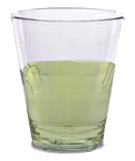
Discoloration Due to Tannins
A: Simply put, anything once alive can be considered organic. Tannins are dissolved, decayed organic matter in the water, and generally not a health risk. Tannins appear primarily in river or surface water and swamps, but, often find their way into wells through cracks and fissures in rock formations. Most people drink a form of tannin every day in the guise of tea or coffee.
Tannins will generally cause a yellow, yellow/brownish tinge to the water. They come from decayed vegetation or animal matter and are carbon-based. This is significant because carbon tends to deplete oxygen and tannin-laden waters will reduce the amount of free oxygen in water. This depletion of oxygen helps explain how tannins contribute to the problem of acid water.
Tannins also prevent iron from being oxidized and precipitated (process whereby iron is changed from a dissolved form to a particle). Tannins in water are responsible for many failures of iron removal filter systems and water softeners. Sometimes organic matter will bind with heme iron (organic iron found in hemoglobin*) and will cause the iron to pass through an oxidation/precipitation process while remaining in dissolved form. The best way to remove the iron in cases such as this is to treat the iron as an organic and remove it with a tannin filter media.
Q: How are tannins measured?
A: There are so many variations of tannins that they are hard to define and measure with standard testing. We have heard of estimates of 12,000 different types of tannins. Some companies offer Lignin Test Kits or more advanced labs have a T.O.C. (Total Organic Carbon) test, but, neither test is foolproof.
An “eyeball test” for tannins can be an effective way to estimate the amount of tannins in your water. First fill a white Styrofoam cup with the water sample, leave it sit out for 30 minutes, and then observe the color.
|
Tannin Concentration in Parts Per Million (PPM)
|
Water color
|
|
0 – 0.5
|
Faint tinge of yellow
|
|
0.5 – 2.0
|
Darker golden yellow (ginger ale)
|
|
2.0 – 3.0
|
Light tea color
|
|
3.0 – 5.0
|
Dark tea color
|
Q: How does a tannin filter work?
A: Would you believe no one has all the answers to this question?
Tannin filter media is made in many different variations. Some work on an ion exchange principal, and some work through adsorption. Some even work as a mechanical filter. Most tannin filter media work using more than one method.
The Water Doctor uses several methods for removing Tannins based on your water testresults and usage.
*hemoglobin: Any of numerous iron-containing respiratory pigments of red blood cells from various organisms
JC Galloway & Son – The Water Doctor is your premier water purification and water softener service in
Apopka, Altamonte Springs, Astatula, Bay Lake, Belle Isle, Beverly Beach, Bostwick, Bunnell, Casselberry, Clermont, Crescent City, Daytona Beach, Daytona Beach shores, Daytona North, DeBary,
DeLand, Deltona, Eatonville, East Palatka, Edgar, Edgewater, Edgewood, Eustis, Flagler Beach, Fruitland Park, Florahome, Georgetown, Grandin, Groveland, Heathrow, Holliste, Holly Hill, Howey In The Hills, Interlachen, Lady Lake, Lake Buena Vista, Lake Como, Lake Mary, Leesburg, Longwood, Maitland, Marineland, Melrose, Mondikes, Oakland, Ocoee, Orange City, Orlando, Ormond Beach, Osteen, Ovido, Palatka, Palm Coast, Pierson, Pomona Park, Putman County, Putman Hall, Sanford, San Mateo, Satuma, Seminole County, Tavares, Umatilla, Welaka, Winter Springs, and the rest of Volusia County in Florida. We also serve neighboring Flagler County, Brevard County, Orange County, Seminole County, and Lake County including the areas of Paisley & Sanford. If you are in the area surrounding Deltona & DeLand, Fl, we have you covered!
